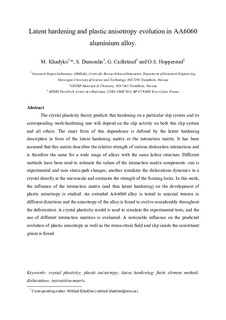| dc.contributor.author | Khadyko, Mikhail | |
| dc.contributor.author | Dumoulin, Stephane | |
| dc.contributor.author | Cailletaud, Georges | |
| dc.contributor.author | Hopperstad, Odd Sture | |
| dc.date.accessioned | 2017-11-29T11:48:53Z | |
| dc.date.available | 2017-11-29T11:48:53Z | |
| dc.date.created | 2015-12-02T14:28:32Z | |
| dc.date.issued | 2016 | |
| dc.identifier.citation | International journal of plasticity. 2016, 76 51-74. | nb_NO |
| dc.identifier.issn | 0749-6419 | |
| dc.identifier.uri | http://hdl.handle.net/11250/2468517 | |
| dc.description.abstract | The crystal plasticity theory predicts that hardening on a particular slip system and its corresponding work-hardening rate will depend on the slip activity on both this slip system and all others. The exact form of this dependence is defined by the latent hardening description in form of the latent hardening matrix or the interaction matrix. It has been assumed that this matrix describes the relative strength of various dislocation interactions and is therefore the same for a wide range of alloys with the same lattice structure. Different methods have been used to estimate the values of the interaction matrix components: one is experimental and uses strain-path changes; another simulates the dislocations dynamics in a crystal directly at the microscale and estimates the strength of the forming locks. In this work, the influence of the interaction matrix (and thus latent hardening) on the development of plastic anisotropy is studied. An extruded AA6060 alloy is tested in uniaxial tension in different directions and the anisotropy of the alloy is found to evolve considerably throughout the deformation. A crystal plasticity model is used to simulate the experimental tests, and the use of different interaction matrices is evaluated. A noticeable influence on the predicted evolution of plastic anisotropy as well as on the stress–strain field and slip inside the constituent grains is found. | nb_NO |
| dc.language.iso | eng | nb_NO |
| dc.publisher | Elsevier | nb_NO |
| dc.title | Latent hardening and plastic anisotropy evolution in AA6060 aluminium alloy | nb_NO |
| dc.type | Journal article | nb_NO |
| dc.type | Peer reviewed | nb_NO |
| dc.description.version | acceptedVersion | nb_NO |
| dc.source.pagenumber | 51-74 | nb_NO |
| dc.source.volume | 76 | nb_NO |
| dc.source.journal | International journal of plasticity | nb_NO |
| dc.identifier.doi | 10.1016/j.ijplas.2015.07.010 | |
| dc.identifier.cristin | 1296125 | |
| dc.relation.project | Norges forskningsråd: 237885 | nb_NO |
| dc.description.localcode | Copyright © 2015 Elsevier Ltd. This is the authors' accepted and refereed manuscript to the article. | nb_NO |
| cristin.unitcode | 194,64,45,0 | |
| cristin.unitname | Institutt for konstruksjonsteknikk | |
| cristin.ispublished | true | |
| cristin.fulltext | postprint | |
| cristin.qualitycode | 2 | |
